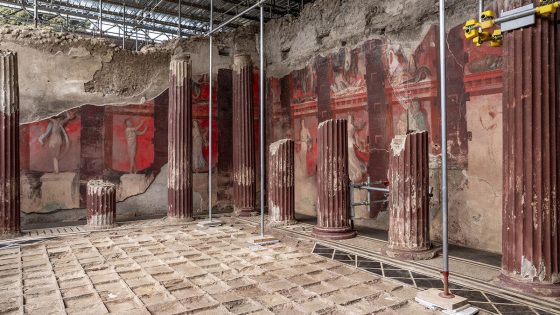Newly discovered frescoes at Pompeii reveal insights into a wine-fueled cult dedicated to Dionysus, the ancient Greek god of wine. The Pompeii Archaeological Park announced the finding of a large frieze in a banquet hall, dating back to 40-30 BCE, showcasing initiation rites involving bacchantes and satyrs in a scene of revelry.
- New frescoes depict wine-fueled cult rituals
- Frieze dates back to 40-30 BCE
- Bacchantes represent wild, untamable women
- Art served decorative and religious purposes
- Pompeii offers insights into ancient life
- Eruption preserved city for future study
The frescoes highlight a vibrant aspect of life in Pompeii, illustrating a cult that celebrated the wild and untamable side of women through ritualistic dances and feasts. The artwork depicts female followers, known as bacchantes, alongside satyrs, engaging in ecstatic celebrations, which included dancing and the consumption of wine. This frieze is part of a larger artistic tradition that connects to ancient rites dating back to the Mycenaean and Cretan cultures.
Key details of the discovery include:
- The frieze covers three walls of a banquet hall.
- It dates back to 40-30 BCE, prior to the eruption of Mount Vesuvius.
- The artwork serves both a religious and decorative purpose, similar to modern restaurant decor.
Gabriel Zuchtriegel, director of the Pompeii Archaeological Park, noted that while the frescoes have deep mythological meanings, they also reflect the social practices of the time. He emphasized that these images convey a sense of liberation for women, contrasting with the traditional roles often depicted in ancient art. The findings underscore Pompeii’s dynamic culture, characterized by both indulgence and ritual.
This discovery at Pompeii not only enriches our understanding of ancient religious practices but also highlights the complexity of social life in a city that thrived on both pleasure and spirituality.

































